Romantic Route, Germany
Visit Date: 1995 -- 2000AD@
The "Romantic Route" might be considered as an ideal place for tourists who would like to see good and old Germany. This route of only 350 km distance would make visitors recollect their dear native places, where many towns of long histories and cultures are scattered. The Romantic Route is the most popular route, although many named routes exist in Germany, for examples, Fairy Tale Route and Erika Route in the north, Old Castle Route, Fantastic Route, and Alpen Route in the south.
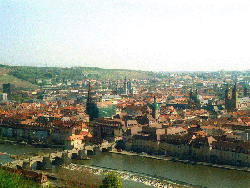
Wurzburg Visit Date: April, 1997
The city of Wurzburg is the starting town of Romantic Route and has histories of being the place of an archbishop in 8th century and lasting such prosperities of religion and trade until Napoleon era. The principal church (Dom), the baroque palace (Residenz) of the largest scale in Germany, and the Marienberg Fort are counted as glorious rememberings. This photo, taken from the Marienberg Fort, shows Dom in the center, Old Main Bridge in the bottom, and Residenz in th right end.
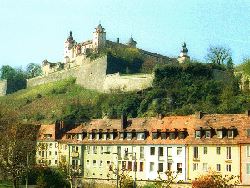
The history of Wurzburg City was started from this Marienberg Fort, which had been the residence of an archbishop between 13 and 18 centuries and also the symbols of power and wealth. Tnere are two museums, i.e., Lord-Bishop Museum as one, and Main-Franken Museum as the other. The famous Scuplture by Riemenschneider and various wine-related expositions are found inside the Main-Franken Museum.
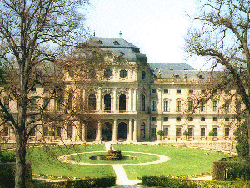
The baroque palace (Residenz), one of the most beautiful palace in Europe, is designated as an UNESCO World Heritage. This was constructed as a living quarter of an archbishop in 1744, at the ceilings of which the marverous fresco pictures by Zick and Tiepolo are painted. In the outside garden, many excellent sculptures of infants are arrranged to enjoy nice and comfortable walking.
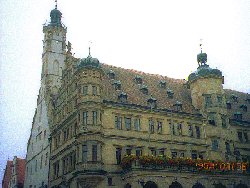
Rotenburg Visit Date: October, 1995
Very dense misty weathers are normally present in October in Europe, and sometimes dangerous for card riving due to the very bad range of vision. We had a dense foggy weather when visiting Rotenburg, and could not see the near rows of houses.
Rotenburg is called as a jewel of medieval ages, and is a high-lighted place of Romantic Route with number of tourists. Started as a free city in 1274, this was expanded and declined at last. The city walls and rows of houses are beautifully remained as medieval items.
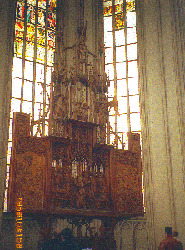
Sanct-Jacob Church of gothic form, the principal church in Rotenburg town, was constructed in 14 century. The stained-glasses in east side are important heritages from viewpoint of the religious art history. At the second floor in west side, "Sacred Blood Altar" by Riemenschneider is exposed. He was famous for making sculpture as live, belonged to the progressivism, and received the tragedy of his hands being broken by the political leader at that time fearing to utilize his sculpture as political propaganda.
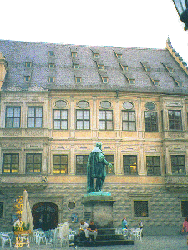
Augusburg Visit Date: September, 1995
This city was built as Roman Emperor's town in the very early stage of 1st century, and since 16 century it had been the commercial center city in Europe with Fugger families. This place is famous for settling religious reconciliation between catholic and protestant parties in 1555. This town is the birthplace for many historic people, such as Brecht "drama author", Leopold "father of Mozart", Holbein "rennaissance painter", and Diesel "engine inventor". This is now the thir biggest economic city in Bayern State and the largest town in Romantic Route.
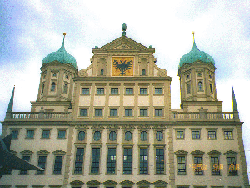
This city hall is one of the largest buling of rennaissance form in Germany, built in 1615. The "Golden Room" was burnt down during World War II, and recovered in 1985 to celebrate 2000 anniverssaries by the city people donation. This hall is famous for a lttle different round roofs at left and right sides.
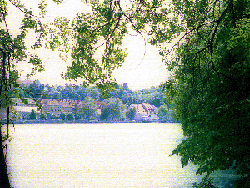
Landsberg Visit Date: May, 2000
This town was completed in half-circular shape along Lech River, a branch river of the Donau. We could enjoy the calm atmosphere with comparative less tourists than others. This town is featurized as fresh and beatiful spot by very clear streams from Fussen, the last town in Romatic Route.
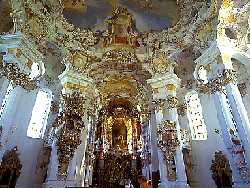
Wieskirche(church) Visit Date: May, 2000
We found this church on the silent meadow hill, being a little apart from the main Romantic Route. This church of small scale is one of the representative churches in Lococo form, bulit by Zimmermann. We had to stand still with surprise for looking his last and marvelous masterpiece.
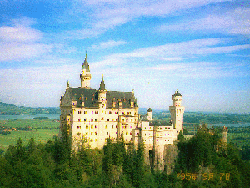
Neuschwanstein Visit Dates: Sepetember, October, 1995: May, 2000
We see fresh green fields and forests in the vicinity of the mountain ranges, as a typical Bayern landscape. We could see distantly the white beautiful catsle in the middle skirt of the mountain, and that is "Neuschwanstein" Catsle, meaning "New-Swan-Stone" Castle.
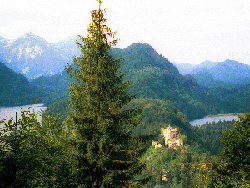
The "Hohen-Schwangau" meaning "High-Swan-Land" is the castle where the Bayern last king Ludwich II was born and was grown up. He built "Neuschwanstein" with the big expense to result in bankrupcy of Bayern Kingdom. He was the strong supporter of Richard Wagner, and this composer visited several times this royal-golden colored castle. Fussen, the goal town of Romantic Route was very near, and is the passing point in Alpen Route. This town is the border city to Austrian Tirol, and offers nice views of Alps ranges for tourists.










